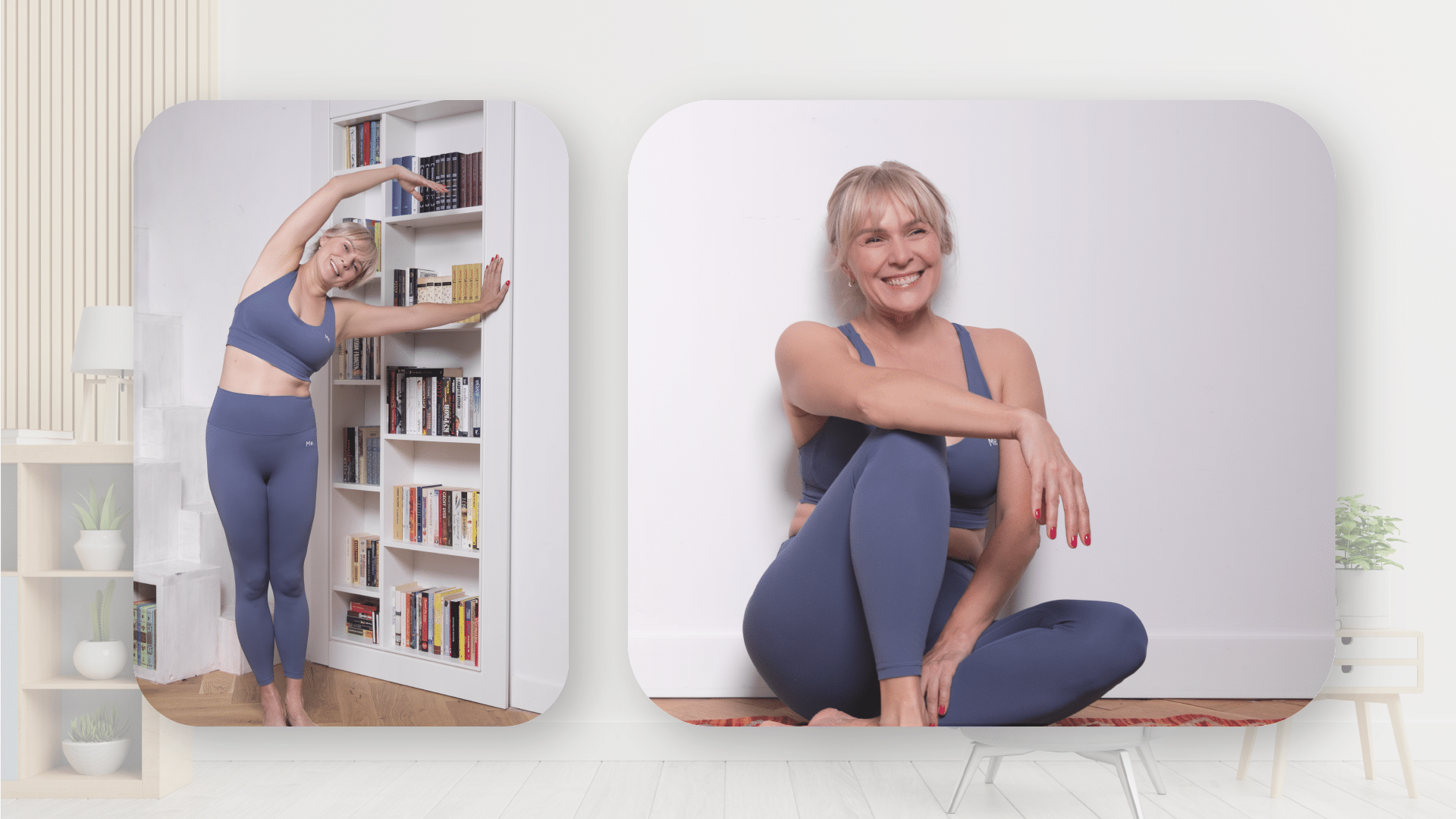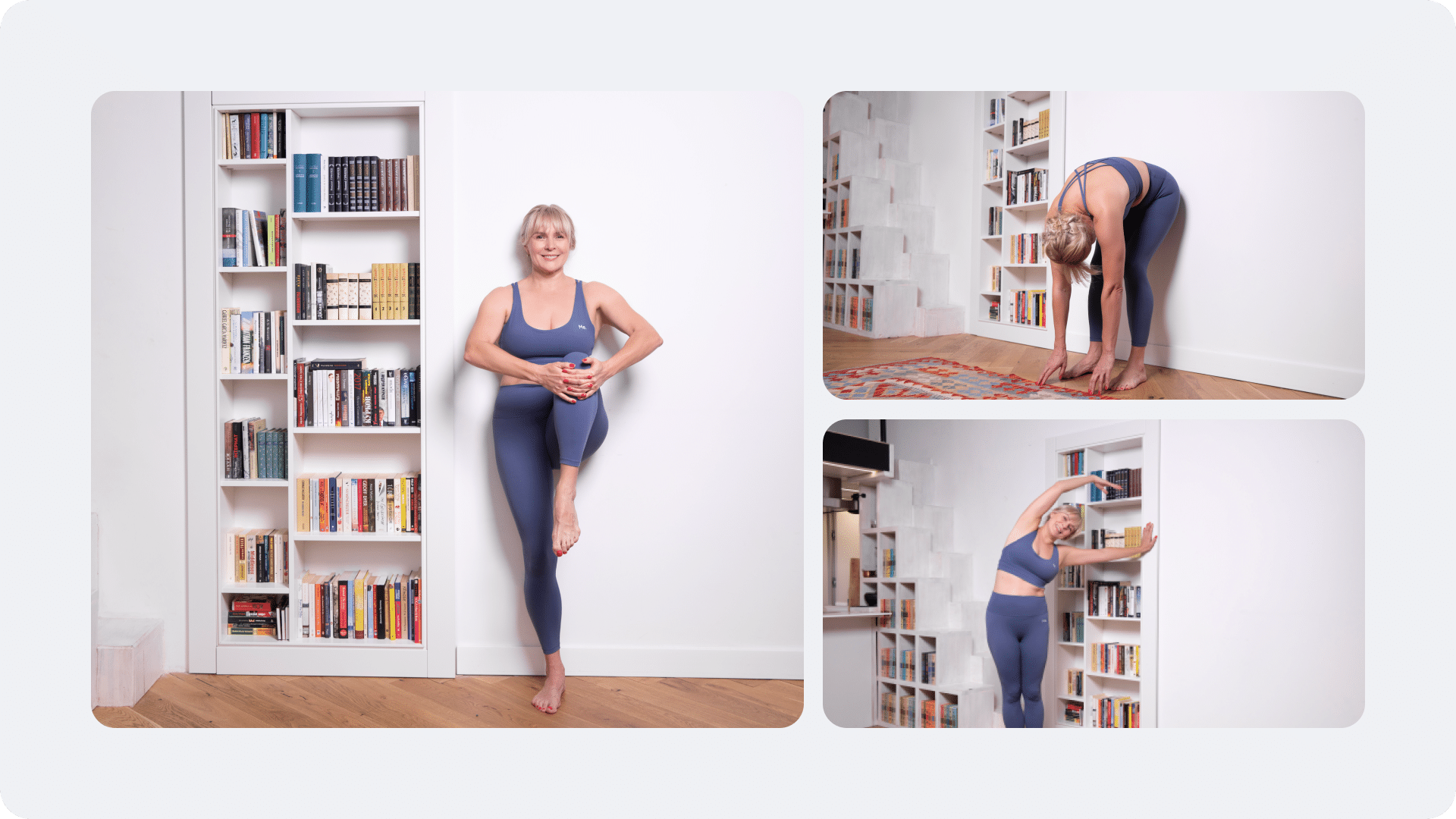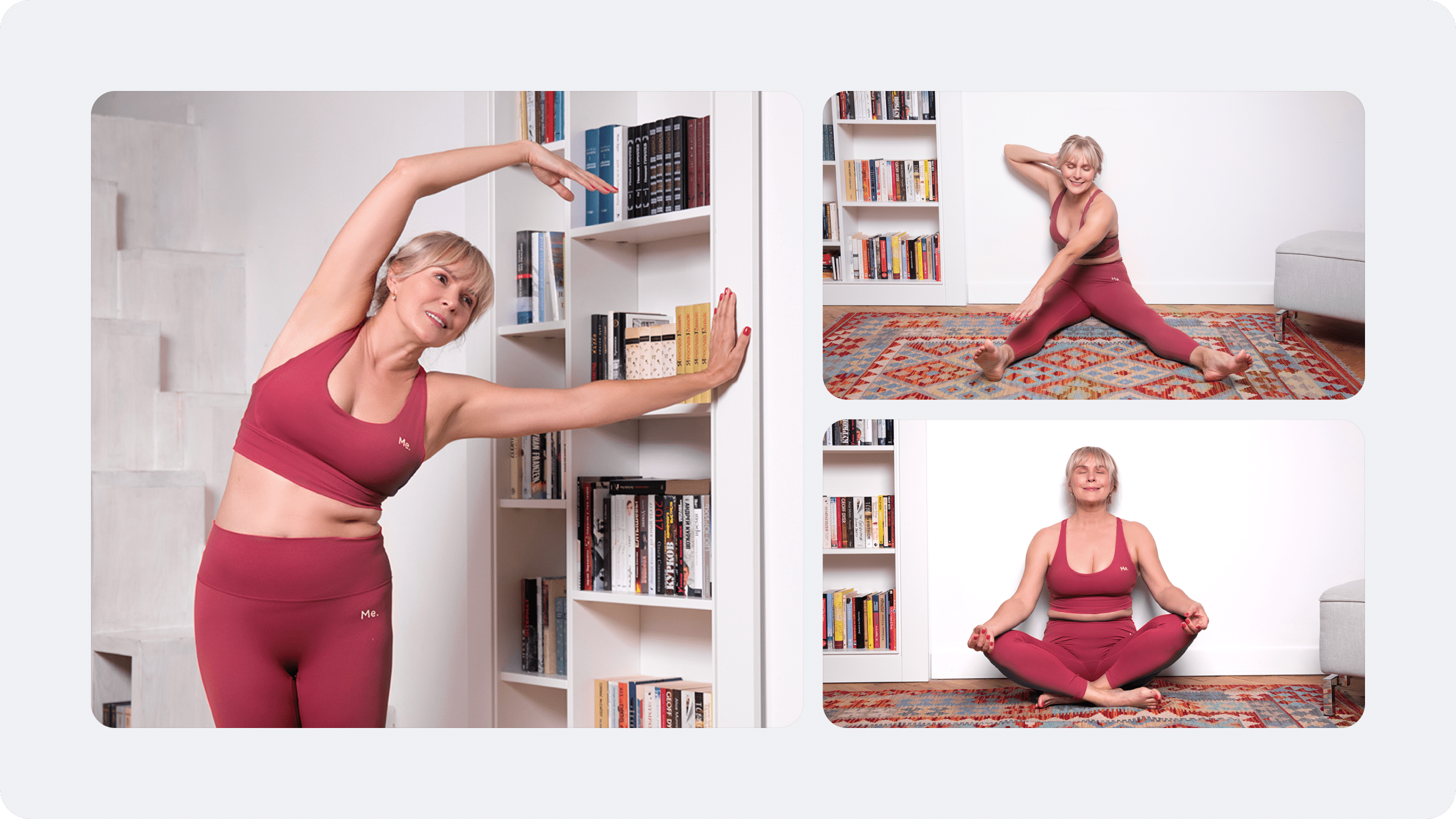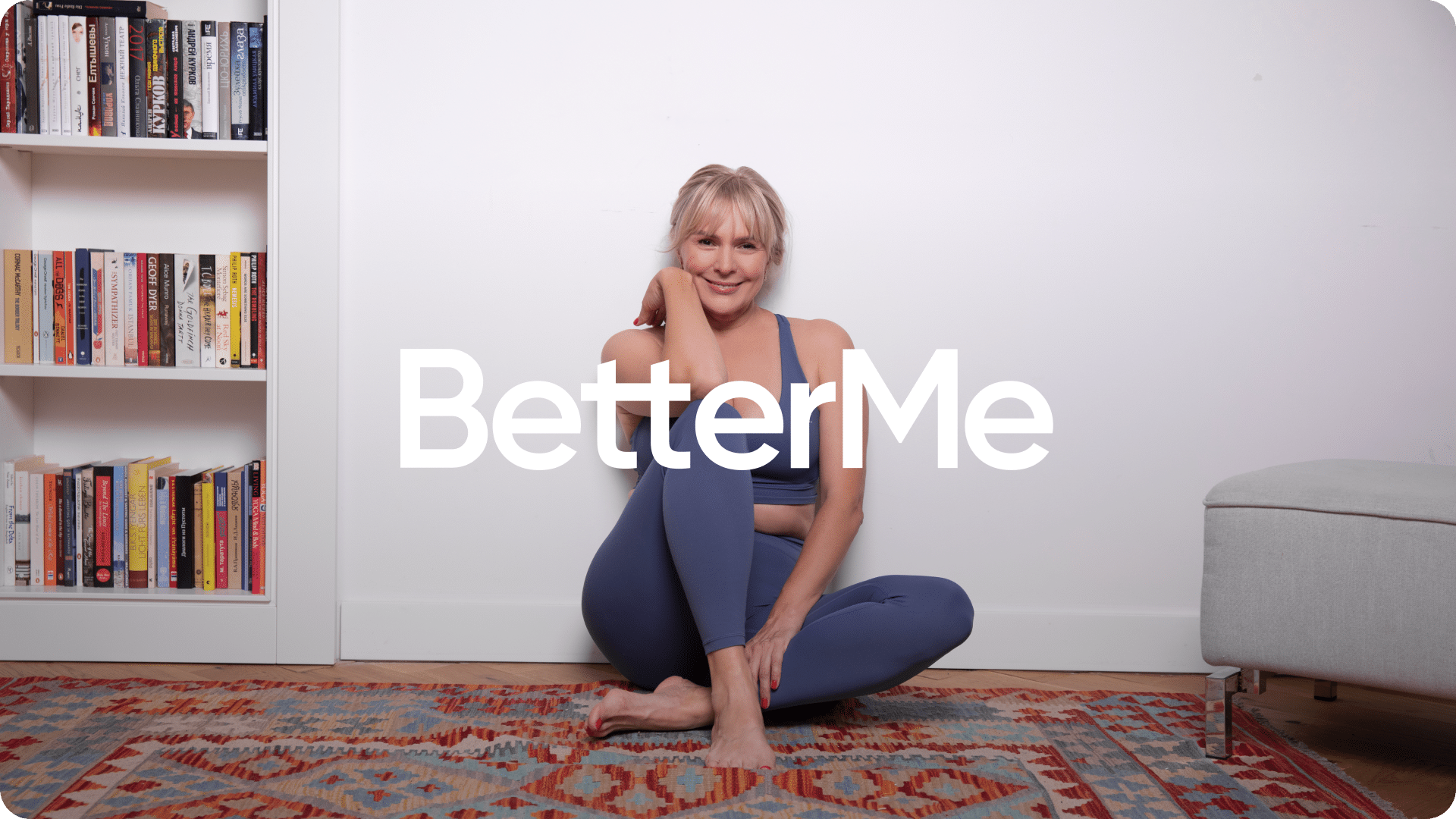Many of us can attest to the fact that the statements ‘stand up straight’ and/or ‘sit up straight’ were part of our childhoods. Good posture is important in day-to-day life as it helps with maintaining balance, reducing tension in the shoulders and neck, reducing the risk of injury at the gym, improving athletic performance, and much more (19).
While posture is important in people of all ages, it is especially important for older adults. Seniors are at increased risk of losing their balance leading to an increased risk of falls and injury. Improving posture helps improve balance thus reducing all these other risks.
Aside from this, improved posture in seniors can also help improve their self-confidence, and circulation, and reduce or even prevent pain and strain in their back, neck, and shoulders. Posture exercises for seniors are one of the best ways to improve how they sit and stand, which can lead to many benefits.
But which are the best exercises to improve poor posture in seniors? Read on to find out!
How Can Seniors Improve Their Posture?
As a senior who is trying to improve your posture, there are several things that you can do to not only fix your posture but improve your balance as well. They include:
Sitting up straight
Yes, whatever your parents told you when you were younger was true. Sitting and standing up straight can go a long way in helping fix your posture.
Because most of us are used to slouching, sitting up straight is not something that will come automatically. Try having a reminder that is at eye level that will remind you to do so. A sticky note on your computer, cubicle or any surface right in front of you will work.
Avoid sitting for too long
Technological advancements, lifestyle changes as well and the simple fact that old age does not support standing or moving around for too long, means that older adults tend to spend a large portion of their days seated.
While this may not seem like a problem and is actually rather comfortable, it is not the best for the health of older adults, and people of all ages.
One study on office workers published in the Journal of Lifestyle Medicine, in 2017, found that prolonged sitting can lead to musculoskeletal disorders of the neck, lower back, and shoulder, obesity, chronic illnesses, metabolic syndrome and premature mortality among other issues (1).
Issues with the musculoskeletal system, i.e, bones, joints and muscles, as well as excess weight can lead to issues with your posture (12, 3, 8)
Intense sweat sessions, working weight loss tips, lip-smacking recipes come in one package with the BetterMe app. And all of it is at your fingertips, start transforming your life now!
Consume more calcium and Vitamin D
Osteoporosis is a chronic musculoskeletal condition that affects a large percentage of older adults with women more than men being the largely affected demographic (11, 18).
Because osteoporosis leads bones to become weaker and more brittle, it can lead to worse posture, less balance, and a higher risk of injury when falls do occur. A recent review of 26 clinical trials revealed that taking vitamin D and calcium supplements increases bone strength slightly in older adults (16).
Stronger bones could in turn help improve your posture, and balance and reduce the risk of older adults falling. Supplements are not the only source of these minerals and vitamins. A diet rich in fatty fish and fish liver oils as well as exposure to the sun can increase vitamin D in the body. Calcium can be found in a variety of foods including but not limited to beans, green leafy vegetables, milk, most cheeses, nuts and seeds, salmon and canned sardines, tahini, yogurt, etc.
Wear supportive shoes
Just because a shoe looks good, doesn’t mean that it will be good for your feet or your posture (14). In older adults, picking shoes that are supportive will not only help improve their posture but it could also reduce walking instabilities and thus the risk of falling.
Studies done on the effect of footwear on the balance, posture, stability, and mobility of older adults suggest that older adults should stick to either minimalist shoes or supportive shoes, designed to reduce the risk of falling instead of normal, conventional shoes (6, 10).
Exercise
While all the above tips will help seniors (and anyone else) improve their posture, the results will not be perfect if one does not incorporate exercises to help increase their muscle, joint, and bone strength.
Exercises that target the core, pelvic floor, as well as the back/spine, should always be included on any list of the best posture exercises for seniors. Remember that not only does the core stabilize the spine and trunk, but research shows that a strong core helps improve your back strength, balance, and muscular endurance (2).
Strong pelvic floor muscles improve sexual function and boost your core strength and stability and a stronger back helps support the spine which also helps with maintaining good posture (20, 4).
What Exercise Is The Best For Correcting Posture?
There is no one exercise that leads all others on the list of best posture exercises for seniors. To help yourself – or an older adult around you – fix their posture, you need a routine that combines different exercises. Here is a list of some posture exercises for seniors that could be beneficial:
Weight bearing exercises
These are exercises that involve moving the body’s weight against gravity with the legs and feet supporting the body’s weight.
These exercises can range from high impact (hiking, any activity that requires high jumping) to moderate impact (jogging, tennis and other racket games, basic dancing) and even low impact (i.e. walking, slow dancing, stair climbing, strength exercises like squats, etc.).
Research on weight bearing exercises shows that these kinds of workouts can help increase bone density and slow down bone loss in osteoporotic patients – a disease that we have seen can lead to bad posture (13, 15).
Depending on the strength and agility of the senior in question, weight bearing exercises such as dance, jogging, hiking, stair climbing, water aerobics, exercise ball workouts, tennis, etc. can help them improve their posture through better bone density.
Chair Exercises
Whenever chair exercises for seniors are brought up in conversation, it’s always as a way to help introduce cardio and strength training to seniors who have balance or mobility problems. While these workouts certainly work for this, they can also be used to help improve their posture.
Some seated posture exercises for seniors using the humble chair include:
Shoulder rolls
This exercise also works well to help reduce any tension in your shoulders:
- Start by sitting up nice and tall on the edge of the chair. Let your arms extend towards the floor from your shoulders.
- Wiggle your hands and fingers and make sure they are loose. Rotate shoulders in a forward circular motion, keeping your back straight and take nice steady breaths.
- Then continue to roll your shoulders backward – up towards your ears then down your back.
Elbow curls
Not only can this workout help improve posture in seniors, but it is also a fantastic upper body workout that targets the upper back and shoulder muscles. Here’s how to do it:
- Sit up straight with your feet hip-width apart and pointing straight ahead.
- Place your fingertips on your temples with palms facing forward and thumbs down. Keep your head in a neutral position with a gaze straight ahead to maintain a neutral neck and spine position.
- Simultaneously bring your elbows together in front of your face as far as is comfortable while keeping your fingers on your temples. If they cannot touch, that’s fine too.
- Return to the start position by pulling the elbows apart and squeezing your back till they are in line with your ears. Be sure not to push your hips forward as you bring your arms back.
- This is one rep. Do 10 to 15 reps
Read more: 4 Best Core Exercises for Beginners: 16 Core Workouts for Men, Women, and Seniors
Seated pullovers
This exercise is great for balance and posture as it strengthens your core and back muscles while challenging your front-to-back balance. If you struggle with a hunchback or forward head posture, this exercise could help fix/correct this. Here’s how to do it:
- Sit up tall on the edge of a chair with your feet firmly planted on the ground.
- Bring both hands together in front of you, interlacing your fingers to make one big fist. straight out in front of you at shoulder height.
- Sitting up tall and with your back straight, pull your hands overhead to where they’re comfortable and then back and down towards your hips.
- Keep your arms extended and move slowly, focusing on the stretch and movement of your shoulders and upper back. This is one rep
- Perform this exercise for 10-20 repetitions.
For those older adults who want to try something new, chair pilates can be the next best thing. Like normal pilates, chair pilates for seniors is a gentle way to help improve core strength and flexibility, two factors that will not only improve posture but also the general well-being of older adults.
Try Some Yoga
Yoga is a centuries-old practice that has been shown to have numerous benefits on the human body.
Making this practice part of daily life can enhance muscular strength and body flexibility, promote and improve respiratory and cardiovascular function, reduce stress, anxiety, depression, and chronic pain, improve sleep patterns, and enhance overall well-being and quality of life (7).
In regards to posture specifically, research suggests that yoga can improve this via improved brain function and better mobility and flexibility (5, 17). Some yoga poses that could help improve your posture include:
Chair/Seated Pigeon Pose
- Sit toward the edge of a chair and position your feet slightly in front of your knees, hip-distance apart. Cross your right ankle over your left thigh.
- Keep your right foot and ankle active by spreading your toes and pressing through the big toe edge of your foot to flex your foot. The closer you bring your right heel toward your left hip, the greater the stretch.
- Stay here or place your hands on your hips and begin to slowly fold forward toward your right thigh
Cat-Cow Stretch
- Start by sitting toward the middle of a sturdy chair with your feet flat on the ground.
- Place your hands on your thighs and inhale arching your back. Open the chest and lift the chin slightly.
- Hold this position for a few seconds then exhale rounding the back, drawing the chin toward the chest.
- This is one rep. Repeat for desired repetitions.
If yoga seems more your speed, a 28-day chair yoga for seniors challenge, could help you make great strides in fixing your back, spine, and posture.
Wall Exercises For Seniors
Wall posture exercises for seniors are another avenue that you can choose to explore. Here is one workout that is perfect for any list of posture exercises for seniors:
- Wall Angels
- Lean on a wall resting your butt, back, shoulders, and head against the wall. Pull your belly button to your spine. This engages the core and keeps a neutral spine.
- Tuck your chin slightly and then reach your arms straight up and put them on the wall overhead. Try to get your hands to touch the wall behind you thus creating a ‘V’.
- Slowly bend your elbows and slide the arms down the wall till just above your shoulders. Make sure that your butt, back, shoulders, and head do not come off the wall as you do this.
- Push the arms back up to the initial ‘V’ position. This is one rep.
- Repeat for as many reps as desired;
Whether you’re looking to simply pep up your fitness routine, jazz up your diet with mouth-watering low-calorie recipes or want to get your act together and significantly drop that number on your scale – BetterMe app has got you covered! Improve your body and revamp your life with us!
Can Years Of Bad Posture Be Solved By Exercise?
Yes, they can. Having bad posture is not a lifelong sentence. By using exercise, you train your muscles to get stronger, improve your bone density, and even train your mind to have a better mind-muscle connection – all factors that can eventually help you sit or stand straighter.
Is 40 Too Late To Fix Bad Posture?
No, it is not. As we’ve mentioned above, fixing your bad posture is all about increased physical activity that strengthens your body, muscles, and bones. This is something that can be done by children, young adults, middle adulthood, and even old age. There is no age limit on when to fix your posture.
Read more: 16/8 Intermittent Fasting for Seniors: Benefits, Meal Plans, and Tips
FAQs
Can You Fix 30 Years Of Bad Posture?
Yes, you can. With the right exercise and dedication, years of bad posture can slowly be improved over time. Adding ergonomic furniture can also help in this process.
How Long Will It Take To Fix Bad Posture?
Like weight loss, fixing your posture is an individual issue that does not have a blanket answer that can fit everyone. However, according to Harvard Health Publishing, you may start to see changes after 6 to 12 weeks of improved habits and posture-correcting exercises (9).
Can Posture Really Be Fixed?
Yes, bad posture can slowly be improved over time with exercise and lifestyle changes. If you feel like your posture problem is too big or complicated, we suggest speaking to a general practitioner, physiotherapist, or osteopath for tests, further information, and advice.
Can Really Bad Posture Be Corrected?
Yes, it can. However, if you are doubtful, schedule an appointment with your doctor to discuss the issue and find possible solutions.
The Bottom Line
Posture exercises for seniors are a great way to help improve the quality of life of many older adults. Because many in this age group are not as strong, we suggest starting slow with easy-to-do moves and workouts – pushing too hard will very likely cause more problems than solutions. For more extreme posture problems, please ask for advice and directions from a licensed medical practitioner.
DISCLAIMER:
This article is intended for general informational purposes only and does not serve to address individual circumstances. It is not a substitute for professional advice or help and should not be relied on for making any kind of decision-making. Any action taken as a direct or indirect result of the information in this article is entirely at your own risk and is your sole responsibility.
BetterMe, its content staff, and its medical advisors accept no responsibility for inaccuracies, errors, misstatements, inconsistencies, or omissions and specifically disclaim any liability, loss or risk, personal, professional or otherwise, which may be incurred as a consequence, directly or indirectly, of the use and/or application of any content.
You should always seek the advice of your physician or other qualified health provider with any questions you may have regarding a medical condition or your specific situation. Never disregard professional medical advice or delay seeking it because of BetterMe content. If you suspect or think you may have a medical emergency, call your doctor.
SOURCES
- Adverse Effects of Prolonged Sitting Behavior on the General Health of Office Workers (2017, ncbi.nlm.nih.gov)
- Anatomical Correlation of Core Muscle Activation in Different Yogic Postures (2017, ncbi.nlm.nih.gov)
- Differences in spinal posture and mobility between adults with obesity and normal weight individuals (2023, nature.com)
- Effective exercises for building a strong back (2024, health.harvard.edu)
- Effects of hatha yoga exercises on spine flexibility in women over 50 years old (2015, ncbi.nlm.nih.gov)
- Effects of supportive and minimalist footwear on standing balance and walking stability in older women (2023, jfootankleres.biomedcentral.com)
- Exploring the therapeutic effects of yoga and its ability to increase quality of life (2011, ncbi.nlm.nih.gov)
- Influence of Obesity on Postural Stability in Young Adults (2016, ncbi.nlm.nih.gov)
- Is it too late to save your posture? (2022, health.harvard.edu)
- Minimal shoes improve stability and mobility in persons with a history of falls (2020, ncbi.nlm.nih.gov)
- Osteoporosis in Aging (2015, newsinhealth.nih.gov)
- Strong, steady and straight: UK consensus statement on physical activity and exercise for osteoporosis (2022, ncbi.nlm.nih.gov)
- The Effectiveness of Physical Exercise on Bone Density in Osteoporotic Patients (2018, ncbi.nlm.nih.gov)
- THE EFFECT OF FOOTWEAR TO THE POSTURE (2020, researchgate.net)
- The impact of adding weight-bearing exercise versus nonweight bearing programs to the medical treatment of elderly patients with osteoporosis (2014, ncbi.nlm.nih.gov)
- Vitamin D and Calcium in Osteoporosis, and the Role of Bone Turnover Markers: A Narrative Review of Recent Data from RCTs (2023, mdpi.com)
- What Has Neuroimaging Taught Us on the Neurobiology of Yoga? A Review (2020, ncbi.nlm.nih.gov)
- What Is Osteoporosis and How Does It Impact Older Adults? (2022, ncoa.org)
- Why good posture matters (2017, health.harvard.edu)
- Women’s pelvic floor muscles (2023, nhsinform.scot)










